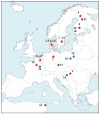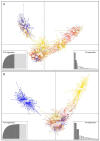Assessing Genetic Variation in Wild and Domesticated Pikeperch Populations: Implications for Conservation and Fish Farming
- PMID: 35565604
- PMCID: PMC9102197
- DOI: 10.3390/ani12091178
Assessing Genetic Variation in Wild and Domesticated Pikeperch Populations: Implications for Conservation and Fish Farming
Abstract
The pikeperch is a freshwater/brackish water fish species with growing interest for European aquaculture. Wild populations show signs of decline in many areas of the species natural range due to human activities. The comparative evaluation of genetic status in wild and domesticated populations is extremely useful for the future establishment of genetic breeding programs. The main objective of the present study was to assess and compare the genetic variability of 13 domesticated populations from commercial farms and 8 wild populations, developing an efficient microsatellite multiplex tool for genotyping. Partial cytochrome b gene sequences were also used to infer phylogeographic relationships. Results show that on average, the domesticated populations do not exhibit significantly lower levels of genetic diversity compared to the wild ones and do not suffer from inbreeding. Nuclear data provide evidence that pikeperch populations in Europe belong to at least two genetically differentiated groups: the first one is predominantly present in Northern Europe and around the Baltic Sea, while the second one comprises populations from Central Europe. In this second group, Hungarian origin populations constitute a differentiated stock that needs special consideration. Aquaculture broodstocks analyzed appear to contain fish of a single origin with only a few exceptions.
Keywords: Sander lucioperca; aquaculture; cyt b; differentiation; microsatellites.
Conflict of interest statement
The authors declare no conflict of interest. The funders had no role in the design of the study; in the collection, analyses, or interpretation of data; in the writing of the manuscript, or in the decision to publish the results.
Figures





Similar articles
-
Genetic consequences of pond production of a pikeperch (Sander lucioperca L.) stock with natural origin: the effects of changed selection pressure and reduced population size.PeerJ. 2020 Mar 17;8:e8745. doi: 10.7717/peerj.8745. eCollection 2020. PeerJ. 2020. PMID: 32211234 Free PMC article.
-
Coastal and freshwater pikeperch (Sander lucioperca) populations differ genetically in the Baltic Sea basin.Hereditas. 2010 Oct;147(5):205-14. doi: 10.1111/j.1601-5223.2010.02184.x. Epub 2010 Sep 14. Hereditas. 2010. PMID: 21039457
-
Genetic structure and dynamics of a small introduced population: the pikeperch, Sander lucioperca, in the Rhône delta.Genetica. 2009 Jan;135(1):77-86. doi: 10.1007/s10709-008-9260-z. Epub 2008 Mar 24. Genetica. 2009. PMID: 18360791
-
Viral haemorrhagic septicaemia virus in marine fish and its implications for fish farming--a review.J Fish Dis. 2005 Sep;28(9):509-29. doi: 10.1111/j.1365-2761.2005.00654.x. J Fish Dis. 2005. PMID: 16266325 Review.
-
How sea lice from salmon farms may cause wild salmonid declines in Europe and North America and be a threat to fishes elsewhere.Proc Biol Sci. 2009 Oct 7;276(1672):3385-94. doi: 10.1098/rspb.2009.0771. Epub 2009 Jul 8. Proc Biol Sci. 2009. PMID: 19586950 Free PMC article. Review.
Cited by
-
Genetic assessment of farmed Oreochromis mossambicus populations in South Africa.PeerJ. 2025 Apr 14;13:e18877. doi: 10.7717/peerj.18877. eCollection 2025. PeerJ. 2025. PMID: 40247840 Free PMC article.
-
Mitochondrial DNA Corroborates the Genetic Variability of Clarias Catfishes (Siluriformes, Clariidae) from Cameroon.Life (Basel). 2023 Apr 22;13(5):1068. doi: 10.3390/life13051068. Life (Basel). 2023. PMID: 37240713 Free PMC article.
-
Genetic Variability Related Behavioral Plasticity in Pikeperch (Sander lucioperca L.) Fingerlings.Animals (Basel). 2025 Jul 29;15(15):2229. doi: 10.3390/ani15152229. Animals (Basel). 2025. PMID: 40805019 Free PMC article.
References
-
- Kestemont P., Dabrowski K., Summerfelt R.C. In: Biology and Culture of Percid Fishes: Principles and Practices. Kestemont P., Summerfelt R.C., Dabrowski K., editors. Springer; Dordrecht, The Netherlands: 2015.
-
- Haponski A.E., Stepien C.A. Phylogenetic and biogeographical relationships of the sander pikeperches (percidae: Perciformes): Patterns across North America and Eurasia. Biol. J. Linn. Soc. 2013;110:156–179. doi: 10.1111/bij.12114. - DOI
-
- Eschbach E., Nolte A.W., Kohlmann K., Kersten P., Kail J., Arlinghaus R. Population differentiation of zander (Sander lucioperca) across native and newly colonized ranges suggests increasing admixture in the course of an invasion. Evol. Appl. 2014;7:555–568. doi: 10.1111/eva.12155. - DOI - PMC - PubMed
-
- FAO . Global Capture Production. FAO FishStat, Fisheries and Aquaculture Department; Electronic Database: 2019.
Grants and funding
LinkOut - more resources
Full Text Sources

